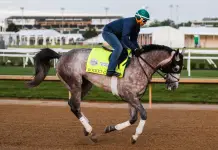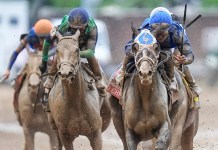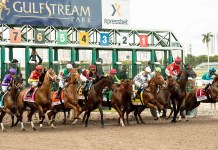Las Vegas
In what world is a maiden winner like Lone Sailor more likely to win the Kentucky Derby than a champion like Good Magic?
Welcome back to racing analytics – especially the two prisms that, when combined, have scored at a nearly 90 percent success rate over the last quarter century.
I know. That looked like an advertisement for a tout who will “east-west” the daylight out of his predictions in order to make specious claims of betting success.
But that is not the case at all. This pair of optics narrows the current Kentucky Derby field down to eight candidates – or even seven – that have a quantifiably better chance to win the race that the rest of the field. They combine the well-known Beyer Speed Figures from the Daily Racing Form with the cult favorite Final Fractions Theory inspired by trainer Phil Thomas and honed for decades by Kentucky turf writer and publicist Jennie Rees.
The Derby has most often been won by a horse that came into the race with a career-high Beyer Speed Figure of at least 95. Since Andrew Beyer invented this statistic 26 years ago to create a common denominator among variables like track bias and race-day conditions, 24 Derby winners checked that 95-or-better box before their Run for the Roses. That is 92 percent. Always Dreaming did it last year, and 11 of the 20 horses currently bound for Churchill Downs qualify on that score. They include the four shortest-priced horses in Derby futures at the Wynn Las Vegas – Justify (5-2), Good Magic (11-2), Magnum Moon (6-1) and Mendelssohn (7-1).
Then there is the other optic that has been researched by Rees going back to 1990. She found that the Derby has most often been won by horses that finished their last 1 1/8-mile prep races with a final furlong of 13 seconds or less and/or a final three furlongs of 38 or less. Including Always Dreaming last year, 25 of the last 28 winners (89 percent) did one or the other, and 21 of 28 (75 percent) did both. Again, 11 of the 20 now in the Derby field meet that standard – but not the same 11 from the Beyer test.
Combine these two criteria, and the field is narrowed to just eight horses – Justify, Magnum Moon, Mendelssohn, Bolt d’Oro (8-1), Audible (9-1), Vino Rosso (16-1), Noble Indy (25-1) and Lone Sailor (50-1).
You noticed that they do not include Good Magic. Yes, the 2017 juvenile champion bounced back from his Fountain of Youth disappointment to win the Blue Grass Stakes two weeks ago. But he came home in 38.1 seconds for the last three furlongs and 13.3 for the last. He may have passed the eye test at Keeneland, but he failed under the Final Fractions Theory.
As Rees explained last year, the Final Fractions Theory “doesn’t really tell you who is going to win, but it eliminates some horses. It exposes the ones that may not want to go that extra eighth of a mile in the Derby.” In other words the clock seemed to show that Good Magic would be running out of gas going 1¼ miles.
Curiously, one race that comes out looking good through both sets of numbers is the Louisiana Derby. Even more telling is that the runner-up Lone Sailor finished the race going faster than the winner Noble Indy. They both came out of the race with career-high Beyers of 95 and final furlongs of 13.0 or better, but Lone Sailor finished faster over the last three furlongs. In fact Noble Indy is the only Derby horse that clocked a sub-13 final furlong but failed to meet the 38-second criterion for the final three.
Here then is the list of potential Derby horses – plus current “also eligibles” Combatant and Snapper Sinclair – with their finishing times in their final preps and their best Beyers:
Mendelssohn’s asterisk comes from the fact that his last prep – the UAE Derby – was about 1 3/16 miles, so his finish did not actually fit into the Final Fractions Theory. The reason Gronkowski (60-1) and My Boy Jack (20-1) do not show up at all is because their final preps were only a mile and 1 1/16 miles, respectively. The last Derby winner that went fewer than nine furlongs in its final prep was Charismatic in 1999.
There are certainly other factors that must influence bettors, especially since few will want to throw eight horses onto the top of an exacta or a trifecta ticket. Critics point out that the Final Fractions Theory does not do any favors for a horse that may be wrapped up by his jockey at the end of a blow-away victory.
“I don’t consider a final three furlongs in 38 being all that special,” Eclipse Award-winning writer and handicapper John Scheinman said on this week’s Ron Flatter Racing Pod for VSiN. “I think that would encompass a lot of horses. I do think that the Beyer Speed Figures, as much as they are maligned in the trolling world of social media, become extremely valuable and strong in picking a Kentucky Derby winner.”
Trolling world or not, Christopher Ado of Torrance, Calif., responded to my Twitter post of the Final Fractions Theory, saying, “This does not address the early pace of a race. In the case of Magnum Moon (in the Arkansas Derby) it was slow early and fast late.”
A Tweet from Thebig1five pointed out that the final furlong and three-furlong times “are related to early fractions and amount of early pressure.”
Trying to find an analytical laser that pierces the skepticism and pinpoints a winner in two weeks, Scheinman may have boiled it down to the simplest requirement of all.
“Someone told me that since the advent of the points system that Churchill Downs put in place to get into the Kentucky Derby that no horse has won the Derby without winning his final prep,” he said. “I don’t know if that’s going to hold, but that is a powerful angle.”
It is true, and the sample size is bigger than that – but not much. The last Derby winner that failed to win his preceding race was Street Sense in 2010, three years before the points system was started. Applying this standard eliminates Bolt d’Oro and Lone Sailor, leaving a final six of Justify, Magnum Moon, Mendelssohn, Audible, Vino Rosso and Noble Indy.
Since the business of preps is not conducted behind closed doors, it is no wonder that the race-day favorite has won the Derby every year since the points system was established.
“It’s taken a lot of the magic out of it,” Scheinman said. “It almost makes it into a coronation more than a great betting exercise.”
But before we simply hand over the garland of roses to Justify, don’t forget the hackneyed fact that Apollo in 1882 was the only horse to win the Derby without racing as a 2-year-old. Justify would be bucking that trend. So would Magnum Moon. And no UAE Derby winner like Mendelssohn has ever finished better than fifth in Kentucky. And despite last year’s win Todd Pletcher’s horses have lost 46 of 48 times in the Derby, eliminating Audible, Vino Rosso, Noble Indy and, again, Magnum Moon.
So let’s see. That now leaves us with nobody likely to win the Kentucky Derby. We may have to find some more analytics.
To be continued.
Racing notes and opinions
Tight end Rob Gronkowski may or may not play for the New England Patriots this season. But he seems certain to show up at Churchill Downs to make the pre-race walk for the Kentucky Derby. It was announced this week that he became a minority owner of the 3-year-old English colt Gronkowski, a long-shot to come over and win the Derby. No sale terms for the “substantial stake” were announced, leading to speculation that Gronkowski – the tight end – did not pay a cent but will get a cut of any earnings in exchange for his good name. Based in Dubai, Phoenix Thoroughbreds are the main owners. Bloodstock advisor Kerri Radcliffe, an NFL fan, is the one who named the Kentucky-bred colt after she bought him in England last April. The colt is trained by Jeremy Noseda, who is splitting up from his wife, who happens to be Radcliffe, who no longer works for Phoenix. And you thought there was drama surrounding Gronkowski – the tight end.
Last year’s Jockey Club Gold Cup winner Diversify (8-5), a lightly raced 5-year-old gelding that has not trailed in any of his last three races, is the morning-line favorite for the $1.2 million Grade 2 Charles Town Classic on Saturday at 5:36 p.m. EDT. But in nine previous runnings of the three-turn, nine-furlong race, only one other speed horse – Stanford two years ago – led the whole way to win it. As usual Írad Ortiz Jr. will ride Diversify, which is making his 2018 debut for trainer Richard Violette. The well-traveled 6-year-old War Story (5-2) comes off a stakes win at Tampa Bay Downs last month to be the second choice. Deep closer Fear The Cowboy (9-2) drops in class after finishing a fourth in the Pegasus World Cup and third last month in the very wet Santa Anita Handicap, losing those races by an average of 12½ lengths. The 7-year-old gelding Something Awesome (8-1), winner in 4 of 5 races the past five months on the dirt at Laurel, may be worth a look.
Giant’s Causeway, one of the top American stallions for the Irish racing giant Coolmore, died in Kentucky on Monday at age 21. As a racehorse he won five consecutive Group 1 races in England and Ireland for trainer Aidan O’Brien before coming back to America to duel Tiznow in a memorable stretch run at the 2000 Breeders’ Cup Classic. After being retired to stud, Giant’s Causeway produced such stars as Shamardal, First Samurai and Take Charge Brandi and would become North America’s top stallion three times between 2009 and 2012.
Jockey Chantal Sutherland has moved back to her native Canada, riding full-time now at Woodbine near Toronto. Sutherland, 42, reached career highs early this decade in southern California with Game On Dude, one of the best American horses that never won an Eclipse Award. According to Equibase, Sutherland’s career earnings total $51,275,727 with 1,025 wins from 8,255 starts.
Ron Flatter’s racing column is posted every Friday morning at VSiN.com. You may also hear the Ron Flatter Racing Pod, also posted Friday mornings at VSiN.com/podcasts. Guests this week include Eclipse Award-winning writers John Scheinman and Tim Layden. Also a handicapper, Scheinman discusses trends and specifics about next month’s Kentucky Derby field. The longtime racing writer for Sports Illustrated, Layden pays tribute to his predecessor William Nack, who died last Friday. Please subscribe and post a review where available at Apple Podcasts, Google Play Music and Stitcher.





